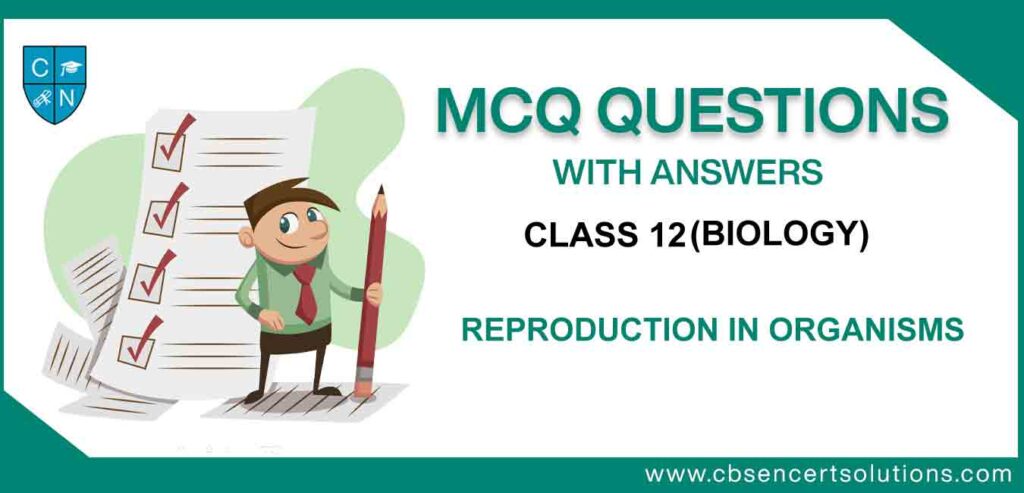Check the below NCERT MCQ Class 12 Biology Chapter 1 Reproduction in Organisms with Answers available with PDF free download. MCQ Questions for Class 12 Biology with Answers were prepared based on the latest syllabus and examination pattern issued by CBSE, NCERT and KVS. Our teachers have provided below Reproduction in Organisms Class 12 Biology MCQs Questions with answers which will help students to revise and get more marks in exams
Reproduction in Organisms Class 12 Biology MCQs Questions with Answers
Refer below for MCQ Class 12 Biology Chapter 1 Reproduction in Organisms with solutions. Solve questions and compare with the answers provided below
Question. Offsets are produced by
(a) meiotic divisions
(b) mitotic divisions
(c) parthenocarpy
(d) parthenogenesis.
Answer
B
Question. An example of rhizome is
(a) Garlic
(b) Colocassia
(c) Ginger
(d) Onion
Answer
C
Question. Reproducing new plants by cells instead of seeds is known as:
A) Biofertiliser
B) Mutation
C) Tissue culture
D) Antibiotics
Answer
C
Question. Offsprings of oviparous animals are at greater risk of survival as compared to those of viviparous animals because
(a) proper embryonic care and protection is absent
(b) embryo does not develop completely
(c) progenies are of smaller size
(d) genetic variations do not occur.
Answer
A
Question. Which of the following is not a distinct stage of sexual reproduction :
(1) Pre gametogenesis stage
(2) Pre fertilisation stage
(3) Fertilisation stage
(4) Post fertilisation stage
Answer
(1) Pre gametogenesis stage
Question. Based on cellular mechanisms there are two major types of regeneration found in the animals.Which one of the following is the correct example of the type mentioned?
(a) Morphallaxis – Regeneration of two transversely cut equal pieces of a Hydra into two small Hydras.
(b) Epimorphosis – Replacement of old and dead erythrocytes by the new ones.
(c) Morphallaxis – Healing up of a wound in the skin.
(d) Epimorphosis – Regeneration of crushed and filtered out pieces of a Planaria into as many new Planarians. from chapter
Answer
A
Question. Modified stem present in Gladiolus is:
A) Bulb
B) Rhizome
C) Corm
D) Bulbil
Answer
C
Question. In oogamy, fertilisation involves
(a) a small non-motile female gamete and a large motile male gamete
(b) a large non-motile female gamete and a small motile male gamete
(c) a large non-motile female gamete and a small non-motile male gamete
(d) large motile female gamete and a small nonmotile male gamete
Answer
B
Question. Which of the following is viviparous?
(a) Cockroach
(b) Scorpion
(c) Bee
(d) Butterfly
Answer
B
Question. Viviparity is found in
(a) Sharks
(b) lizards
(c) frogs
(d) birds
Answer:
(a) Sharks
Answer
A
Question. Which one of the following pair is correctly matched?
A) Onion – Bulb
B) Ginger – Sucker
C) Chlamydomonas – Conidia
D) Yeast – Zoospores
Answer
A
Question. In ginger, vegetative propagation occurs through
(a) bulbils
(b) runners
(c) rhizome
(d) offsets
Answer
C
Question. Vegetative reproduction takes place in Agave:
(a) By bulbils
(b) By hybrid
(c) By stolon
(d) By rhizome
Answer
A
Question. The term ‘clone’ cannot be applied to offspring formed by sexual reproduction because
(a) offspring do not possess exact copies of parental DNA
(b) DNA of only one parent is copied and passed on to the offspring
(c) offspring are formed at different times
(d) DNA of parent and offspring are completely different
Answer
A
Question. First cell of sporophytic generation is :
(1) Gamete
(2) Spore
(3) Zygote
(4) Embryo
Answer
(3) Zygote
Question. During regeneration, modification of an organ to other organ is known as
(a) morphogenesis
(b) epimorphosis
(c) morphallaxis
(d) accretionary growth.
Answer
B
Question. Anemophily takes place by:
(a) By Bird
(b) By Bat
(c) By Snail
(d) By Wind
Answer
D
Question. Rhizome reproduction is observed in:
A) Solarium tuberosum
B) Ginger
C) Achyranthes
D) All of the above
Answer
B
Planaria’s most remarkable characteristics are its ability to
1. Hibernation
2. Survive without air
3. Generate bioluminescence
4. Regenerate
Answer
4. Regenerate
Question. Which of the following flowers only once in its lifetime?
(a) Bamboo species
(b) Jackfruit
(c) Mango
(d) Papaya
Answer
A
Question Development of new individual from female gamete without fertilisation is termed as
(a) syngamy
(b) embryogenesis
(c) oogamy
(d) parthenogenesis.
Answer
D
Question. Which one of the following plants is monoecious?
(a) Pinus
(b) Cycas
(c) Papaya
(d) Marchantia
Answer
A
Question. What is the duration of juvenile phase in bamboo and interflowering period of Strobilanthus kunthiana respectively :
(1) 50-100 years and 21 years
(2) 50-100 years and 12 years
(3) 25-300 years and 12 years
(4) 25-30 years and 21 years
Answer
(2) 50-100 years and 12 years
Question. Find out incorrect statement :
(1) Period from birth to natural death called life span
(2) Life span of organisms are necessarily correlated with their size
(3) Except single celled organisms, all others are mortal
(4) Reproduction enables the continuity of species, generation after generation
Answer
(2) Life span of organisms are necessarily correlated with their size
Question. Flowers are unisexual in
(a) China rose
(b) onion
(c) pea
(d) cucumber.
Answer
D
Question. cycle is reported in
(a) cows and sheep
(b) humans and monkeys
(c) chimpanzees and gorillas
(d) none of these.
Answer
A
Question. Vegetative propagation in Pistia occurs by
(a) stolon
(b) offset
(c) runner
(d) sucker.
Answer
B
Question. Cultivation of floral plants is known as
(1) Horticulture
(2) Floriculture
(3) Sericulture
(4) Vermiculture
Answer
(2) Floriculture
Question. Which of the following statements is incorrect ?
(i) Bamboo species flower only once in their life time, generally after 50-100 years and produce large number of fruits and die.
(ii) In animals, the juvenile phase is followed by morphological and physiological changes prior to active reproductive behaviour.
(iii) The reproductive phase is of same duration in all organisms.
(iv) Juvenile phase is the period of growth between the birth of an individual till it reaches reproductive maturity.
(a) Only (i)
(b) Only (ii)
(c) Only (iii)
(d) Only (iv)
Answer
C
Question. The process of series of changes from larva to adult after embryonic development is called
(a) regeneration
(b) growth
(c) metamorphosis
(d) ageing.
Answer
C
Question. Where does syngamy occur in algae?
(1) In archegonium
(2) In water or oogonium
(3) In Ovary
(4) In the soil
Answer
(2) In water or oogonium
Question________ is a life process that is not essential for an individual’s survival but for survival of the species.
(a) Growth
(b) Reproduction
(c) Respiration
(d) Nutrition
Answer
B
Question Meiosis does not occur in
(a) asexually reproducing diploid individuals
(b) sexually reproducing haploid individuals
(c) sexually reproducing diploid individuals
(d) all of these.
Answer
A
Question. Parthenogenesis is
(a) development of embryo without fertilisation
(b) development of fruit without fertilisation
(c) development of fruit without hormones
(d) development of embryo from egg without fertilisation.
Answer
D
Question. Bryophyllum daigremontianum reproduces by
1. Vegetative propagation
2. Budding
3. Fission
4. Fragmentation
Answer
1. Vegetative propagation
Question. Which one of the following is correctly matched?
(a) Onion–Bulb
(b) Ginger–Sucker
(c) Chlamydomonas–Conidia
(d) Yeast–Zoospores
Answer
A
Question. The reproduction takes place by gemma :
(a) In higher plants
(b) In lower animals
(c) In some bryophytes
(d) In mammals
Answer
C
Question Which of the following options shows two plants in which new plantlets arise from the same organ?
(a) Dahlia and ginger
(b) Potato and sweet potato
(c) Dahlia and rose
(d) Potato and sugarcane
Answer
D
Question. Which reproductive adaptation is characteristic of most terrestrial vertebrates but not of most aquatic vertebrates?
(a) External fertilization
(b) Internal fertilization
(c) Motile gametes
(d) External development
Answer
B
Question.The property of an undifferentiated cell that has the potential to develop into an entire plant is called
1. Budding
2. Cloning
3. Subpotency
4. Totipotency
Answer
4. Totipotency
Question. Water hyacinth or Eichhornia is one of the problematic weed of static water in India. Which of the following statement is incorrect about it :-
(a) It also known as ‘Terror of Bengal’
(b) It is native plant of India
(c) It increases biological oxygen demand of water body
(d) It spread rapidly through vegetative reproduction.
Answer
B
Question. Select the odd one out with respect to life span
(a) Life span of organism are not correlated with their size
(b) Crows and parrots show wide difference in their life span
(c) Life span of rice is 3-4 weeks
(d) It is the period between birth and natural death of an organism.
Answer
C
Question. Write down the name of fleshy bud that produces new plant in Agave
(a) Bulbil
(b) Bulb
(c) Rhizome
(d) Offset
Answer
A
Question. The fleshy bud which produces new plants in hydrophytes is known as
(a) Bulbil
(b) Sucker
(c) Turion
(d) Runner
Answer
C
Question. The process refers to development of embryo is known as
(a) Gametogenesis
(b) Embryogenesis
(c) Parthenogenesis
(d) Oogenesis
Answer
B
Question. Match the column-A with column-B
Column-A Column-B
(i) Budding (a) Cockroach
(ii) Binary fission (b) Hydra
(iii) Gemmule (c) Amoeba
(iv) Gamete formation (d) Sponge
(a) (i)-b, (ii)-c, (iii)-a, (iv)-d
(b) (i)-b, (ii)-c, (iii)-d, (iv)-a
(c) (i)-d, (ii)-a, (iii)-c, (iv)-b
(d) (i)-d, (ii)-b, (iii)-c, (iv)-a
Answer
B
Question. Select the incorrect match :-
(a) Asexual reproduction – Somatogenic reproduction
(b) Sexual reproduction – Fusion of gametes
(c) Vegetative propagation – Rhizome
(d) Clone – Morphologically similar, genetically dissimilar
Answer
D
Question. Which of the following statement incorrect ?
(a) Asexual reproduction is a rapid mode of repro- duction.
(b) Embryogenesis involves cell division and cell differentiation.
(c) The life spans of organisms correlated with their sizes.
(d) Animals are either unisexual or bisexual.
Answer
C
Question. The continuity of life is maintained by the process of
(a) Respiration
(b) Reproduction
(c) Photosynthesis
(d) Adaptation
Answer
B
Question. Regarding the reproduction which of the following statement is correct :-
(a) Asexual reproduction is common among multicellular plants & animals
(b) In monerans cell division itself a mode of reproduction
(c) Yeast undergo equal type cell division to produce bud
(d) In fungi fission is most common method of asexual reproduction
Answer
B
Question. Which of the following event is post fertilisation event?
(a) Gametogenesis
(b) Gamete transfer
(c) Fertilisation
(d) Embryogenesis
Answer
D
Question. Cell division is itself a mode of reproduction in :-
(a) Protista & all fungi
(b) Protista only
(c) Monera fungi & higher plants
(d) Protista & Monera
Answer
D
Question. Most common special asexual reproductive structure seen in member of algae is :-
(a) Zoospore
(b) Conidia
(c) Sporangia spore
(d) Gemmule
Answer
A
Question. Arrange these animals in the increasing order of their life span :
Crow, Horse, Parrot, Elephant
(a) Horse, Parrot, Crow, Elephant
(b) Crow, Parrot, Horse, Elephant
(c) Crow, Parrot, Elephant, Horse
(d) Crow, Horse, Elephant, Parrot
Answer
D
Question. Estrus cycle is found in
(a) Gibbon
(b) Gorilla
(c) Cow
(d) Monkey
Answer
C
Question. Meiocytes are
(a) Spermatids
(b) Gamete mother cells
(c) Bone marrow cells
(d) Oocytes
Answer
B
Question. External fertilisation occurs in
(a) Mammals
(b) Birds
(c) Reptiles
(d) Bony fishes
Answer
D
Question. Which of the following organism has longest life span?
(a) Elephant
(b) Horse
(c) Crocodile
(d) Parrot
Answer
D
Question. Which of the following animal is bisexual ?
(a) Cockroach
(b) Leech
(c) Monkey
(d) Honey bee
Answer
B
Question. Which of the following animals are seasonal breeder?
(a) Monkey
(b) Human
(c) Bird
(d) Apes
Answer
C
Question. Find out the incorrect statement :-
(a) Period from birth to natural death is called life span
(b) Life span of an organism are necessarily correlated with their size
(c) Except single celled organism all other are mortal
(d) Reproduction enable the species generation after generation.
Answer
B

We hope you liked MCQ Class 12 Biology Chapter 1 Reproduction in Organisms with answers provided above. Incase you have any questions please post them in the comments section below and our Biology teachers will provide a response.
